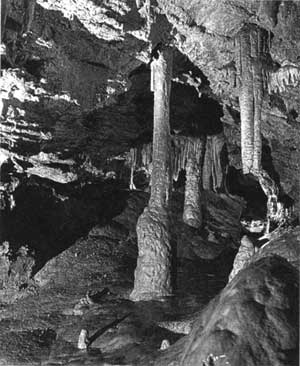|
Volume XXVI - 1995
Moonmilk and Cave-dwelling Microbes
By John Roth
Microbes lie as far from charismatic megafauna such as deer, bears,
and bobcats as you can get. Studying these "forsaken fauna" is difficult
because you cannot see them. Their geologic equivalent is mud, but even
with x-ray diffraction and other high tech methods, the small particle
size of muds can challenge the most dedicated researcher. When combined
in caves, however, microbes and muds can form sediments known as
moonmilk.

formations in Oregon Caves
Oregon Department of
Transporation photo.
|
Even the name has the lure of mystery. Its origin is from the German
Mannlimilch, meaning "little earth-man." European peasants used
moonmilk for centuries to heal infected cuts in livestock. Some believed
that gnomes put this substance in caves for people to use. The white mud
seemed to kill infections and speed healing at supernatural rates. Like
much of what is in folklore, there is more than a germ of truth in these
tales. Much of the calcite moonmilk sampled by investigators contains
actinomycetes, which are the main producers of antibiotics.
Moonmilk is a textural term for a very fine, white cave material
that absorbs a lot of water. Wet moonmilk looks and feels soft and
pasty, somewhat like white cream cheese, when rubbed between the
fingers. Dry moonmilk resembles talcum or chalk powder, in that it feels
hard and crumbly. Moonmilk often contains 40 to 70 percent water, while
organic material may make it even more plastic and slippery.
It is likely that organic activity plays a role in the buildup of
some moonmilk, especially the calcite kind found in Oregon Caves.
Calcite moonmilk can contain such bacteria as Macromonas
bipunctata, along with cyanobacteria, fungi, and green algae. This
microflora probably assists in breaking down minerals in the wall rock
and adding them to the moonmilk. Moreover, researchers have found that
the longer it takes water to reach the cave, the more likely it is that
some of the organics will be consumed enroute. In general, water
dripping into the deeper parts of Oregon Caves has less organic content
than water reaching shallower parts.
Humans have impacted bacteria in moonmilk, as well as other microbe
populations in Oregon Caves. An inventory done around every survey point
in the cave shows a marked decrease in "cave slime" (mostly
actinomycetes bacteria) growing on walls near the cave trail.
Decline in these organisms could well be the result of lint and other
visitor-induced organics that find their way to cave walls. As a result,
non-native bacteria adapted to a high energy food source outgrow and
outcompete the slow growing cave slime adapted to low energy foods. Cave
slime may also have suffered further adverse effects by visitors
touching the cave walls, or through the past practice of spraying those
walls with bleach to control exotic plants.
As an example of their value to resource management in the park,
microbes have been utilized to reconstruct the size and shape of
prehistoric entrances at Oregon Caves. Since the natural openings are
now highly modified, an inventory of the directional orientation of
popcorn-shaped speleothems was needed so that gates could be built with
partial restoration of those conditions resembling prehistoric air flow.
The cave inventory also showed that exotic microbes contributing to
rounded vermiculations (or "clay worms") are more common near the main
trail, while the more complex forms of these lines on cave walls are
prevalent further from the trail. Analysis if the rounded vermiculations
show high amounts of lint and exotic cyanobacteria. The rounded clay
worms will be removed, as they appear to be largely caused by lint and
artificial lights.
Deposition of lint, skin, and hair in Oregon Caves does not appear
to impact native microbes as much as in some other caves administered by
the National Park Service. Knowing this has allowed flexibility in the
design of a new cave trail. Rather than having settling "ponds" and a
foot-high, lint-trapping curb on both sides of the trail along its
entire length, only certain areas will be curbed or have drainage
concentrated. If these areas trap substantial lint and non-native
organic runoff, then additional curbs, drains, and settling ponds will
be added and the areas cleaned more frequently. This system will allow
for a more natural flow of water and air across the trail, yet will trap
lint and other human-associated organics where they might threaten cave
biota. The result should be a better balance between allowing for
visitor use and preservation of the monument's primary resource.
John Roth is the natural resources management specialist for
Oregon Caves National Monument.
|

